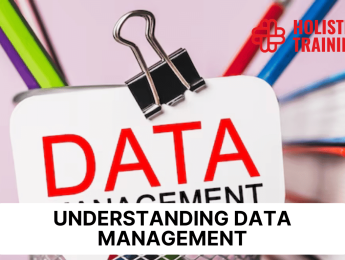- Table of Contents
- Introduction
- Understanding Data Management
- The Significance of Data Management
- Informed Decision-Making
- Compliance and Security
- Enhanced Customer Experience
- Efficient Operations
- Strategic Planning and Innovation
- Risk Management
- Strategic Partnerships and Collaboration
- Continuous Improvement and Adaptability
- Data Management in the Age of AI
- Data Quality Matters Even More
- Scalability and Accessibility
- Ethical Considerations
- Interdisciplinary Collaboration
- AI Model Monitoring and Maintenance
- Data Annotation and Labelling
- Data Privacy in AI
- 8 Best Practices to Improve Your Data Management
- 1. Define Clear Objectives
- 2. Establish Data Governance
- 3. Implement Robust Data Security
- 4. Ensure Data Quality
- 5. Invest in Data Integration
- 6. Embrace Cloud Technology
- 7. Foster a Data-Driven Culture
- 8. Continuously Improve
- Data Management and Predictive Analytics
- 1. Comprehensive Data Gathering
- 2. Data Cleaning and Preprocessing
- 3. Feature Engineering
- 4. Data Storage and Accessibility
- 5. Data Integration for Holistic Insights
- 6. Continuous Monitoring and Updating
- 7. Data Security and Privacy
- 8. Interpretability and Explainability
- 9. Handling Big Data for Scalability
- 10. Real-time Predictive Analytics
- Conclusion
Introduction
Amidst the dynamic interplay of business and technology, data has emerged as a formidable asset driving growth, innovation, and decision-making. As companies harness data-driven insights, the significance of effective data management has grown immensely. In this article, we embark on a journey to explore the world of data management, understanding its critical role, its synergy with AI, and uncovering eight best practices that can revolutionise your company's approach to handling data.
Understanding Data Management
Before we embark on our journey to improve data management, let's establish a clear understanding of what data management entails. Data management refers to the process of collecting, storing, organising, and maintaining data in a way that ensures its accuracy, accessibility, security, and usability. It encompasses a wide range of activities, from data governance and quality assurance to data storage and retrieval. Effective data management is not merely about handling data; it's about leveraging data as a strategic asset to drive informed decision-making and gain a competitive edge in the market.
The Significance of Data Management
Data management is not just a buzzword; it's a pivotal aspect of modern business operations. Here's why it matters:
Informed Decision-Making
In the digital age, data-driven insights are invaluable. Businesses are constantly inundated with vast amounts of data, and deciphering meaningful information from this sea of information is crucial. Proper data management ensures that the data used in decision-making processes is accurate, reliable, and up-to-date. Informed decisions empower businesses to navigate market trends, identify opportunities, and anticipate challenges. For instance, retail businesses can use data analytics to analyse customer preferences and adjust their inventory accordingly, ensuring products are tailored to meet customer demands.
Compliance and Security
With the increasing frequency of data breaches and privacy concerns, data security has become paramount. Data management practices include robust security measures such as encryption, access controls, and regular security audits. Ensuring data security is not only about protecting sensitive customer information; it's also about complying with stringent data protection regulations like GDPR and CCPA. Failure to adhere to these regulations can result in severe financial penalties and loss of trust among customers.
Enhanced Customer Experience
Understanding customers on a profound level is key to delivering exceptional experiences. Data management allows businesses to gain insights into customer behaviour, preferences, and needs. By analysing customer data, companies can personalise their offerings, tailor marketing strategies, and provide excellent customer service. For instance, streaming services use data management to track viewing habits, suggesting movies or shows based on a viewer's history, thereby enhancing user experience and customer satisfaction.
Efficient Operations
Efficient internal operations are the lifeblood of any successful organisation. Data management streamlines processes by facilitating seamless data sharing, reducing redundancy, and optimising resource allocation. For example, supply chain management relies on data to track inventory levels, predict demand, and manage logistics. With effective data management, businesses can optimise their supply chains, reduce costs, and enhance overall operational efficiency.
Strategic Planning and Innovation
Data is not just a tool for the present; it's a roadmap for the future. Properly managed data serves as a goldmine for strategic planning and innovation. By analysing historical data, businesses can identify patterns, trends, and outliers. This knowledge is invaluable for creating innovative products, optimising services, and exploring new market opportunities. For instance, social media platforms analyse user engagement data to introduce new features, enhancing user experience and staying ahead of competitors.
Risk Management
Every business venture involves risks, but data management can mitigate these risks significantly. By analysing historical data and market trends, businesses can anticipate potential risks and develop contingency plans. Moreover, in sectors like finance, data management is crucial for risk assessment and fraud detection. Banks and financial institutions utilise data analytics to identify unusual patterns in transactions, flagging potentially fraudulent activities in real-time.
Strategic Partnerships and Collaboration
Data management not only benefits internal operations but also opens doors to strategic partnerships and collaborations. Businesses can leverage their data assets to forge partnerships with other organisations, sharing insights and driving joint initiatives. For instance, healthcare institutions can collaborate with pharmaceutical companies, sharing patient data (with appropriate privacy safeguards) to accelerate medical research and develop innovative treatments.
Continuous Improvement and Adaptability
The business landscape is in a constant state of flux, with new technologies and market trends emerging regularly. Effective data management equips businesses with the ability to adapt swiftly. By continuously analysing data, organisations can identify areas of improvement, customer preferences, and emerging market trends. This adaptability ensures that businesses remain competitive, responsive to customer needs, and resilient in the face of challenges.
In summary, the significance of data management cannot be overstated. It shapes the core of decision-making processes, ensures regulatory compliance, enhances customer experiences, optimises operations, drives innovation, manages risks, fosters collaborations, and promotes adaptability. Businesses that recognise and harness the power of data management are better positioned to thrive in the dynamic and competitive landscape of the digital age.
Data Management in the Age of AI
The emergence of artificial intelligence has added another layer of complexity to data management. AI thrives on data; the more high-quality data fed into AI algorithms, the better the outcomes. Here's how data management intersects with AI:
AI thrives on data; the more high-quality data fed into AI algorithms, the better the outcomes. Here's how data management intersects with AI:
Data Quality Matters Even More
AI algorithms are hungry consumers of data, relying on vast amounts of accurate and diverse datasets for training. The quality of the data used directly influences the accuracy and reliability of AI outcomes. Poor data quality can lead to biassed models, inaccurate predictions, and ineffective decision-making. For instance, in autonomous vehicles, AI systems rely on high-quality data to recognise and respond to various driving scenarios accurately. Effective data management practices ensure that the data fed into AI algorithms is not only abundant but also reliable, unbiased, and representative of real-world scenarios.
Scalability and Accessibility
AI projects, especially those involving deep learning and complex neural networks, demand substantial amounts of data. Managing this data efficiently, while ensuring easy accessibility for AI processes, is crucial. Traditional data management systems might struggle to handle the volume and complexity of data required for AI applications. Cloud-based storage solutions and data lakes offer scalable options. These platforms allow organisations to store, manage, and process massive datasets, providing the computational power necessary for AI algorithms. Moreover, real-time access to data is vital for AI applications such as fraud detection in financial transactions, where immediate decisions can prevent significant losses.
Ethical Considerations
The rise of AI applications has given rise to ethical concerns surrounding privacy, bias, and transparency. Biassed training data can lead to AI systems that discriminate against certain demographic groups or exhibit skewed behaviour. Ethical data management practices can mitigate these concerns. Ensuring data used for AI training is unbiased and ethically sourced is critical. Ethical data practices involve not only anonymising personal information but also being transparent about data usage and ensuring fairness in data representation. For instance, in AI-driven recruitment platforms, ethical data management practices ensure that hiring algorithms are trained on diverse datasets, reducing biases in the hiring process.
Interdisciplinary Collaboration
AI projects often require collaboration between data scientists, domain experts, and IT professionals. Effective data management fosters interdisciplinary collaboration. Data management professionals ensure that data is structured, clean, and accessible, allowing data scientists to focus on building AI models. In medical research, for instance, data management experts collaborate with healthcare professionals and data scientists to ensure that medical data is curated, allowing AI algorithms to identify patterns and potential treatments accurately.
AI Model Monitoring and Maintenance
AI models are not static entities; they evolve and adapt as new data becomes available. Proper data management is essential for AI model monitoring and maintenance. This includes continuous monitoring of data inputs, model outputs, and feedback loops to identify drifts in data patterns. For example, AI-based chatbots used in customer service require constant monitoring. Data management professionals ensure that the chatbot's training data remains relevant and update the dataset to reflect changes in customer queries and preferences.
Data Annotation and Labelling
AI algorithms, especially in machine learning and deep learning, rely on labelled datasets for training. Data annotation and labelling, a critical aspect of data management, involve tagging data points with appropriate labels. For instance, in image recognition, annotators label objects in images to train AI models accurately. Effective data management ensures that the labelled datasets are consistent, high-quality, and comprehensive, providing a strong foundation for AI training.
Data Privacy in AI
AI applications often deal with sensitive information, such as healthcare records or financial data. Data privacy becomes a paramount concern. Data management practices, including encryption, differential privacy techniques, and secure data sharing protocols, are vital. In healthcare, for instance, AI algorithms can analyse patient data to predict diseases. Secure data management ensures patient privacy is maintained, and sensitive information is not compromised.
In summary, the integration of data management and AI is not a mere technicality; it's a fundamental requirement for the successful deployment and sustainability of AI solutions. Data management ensures that AI algorithms are trained on high-quality, unbiased data, and it supports the ethical and responsible use of AI technologies. Moreover, effective data management enables organisations to navigate the complexities of AI implementation, fostering interdisciplinary collaboration, ensuring data privacy, and facilitating the continuous improvement of AI models. As AI technologies continue to shape various industries, robust data management practices will be the cornerstone of ethical, effective, and innovative AI applications.
8 Best Practices to Improve Your Data Management
Now that we've established the importance of data management, let's dive into eight best practices that can help elevate your company's data management strategy to new heights:
1. Define Clear Objectives
Defining clear data management objectives is akin to setting the compass for your organisation's data journey. These objectives should align with your business goals. For instance, if the objective is to enhance customer insights, the data management strategy might focus on improving data collection methods to create a comprehensive customer profile. Clear objectives provide a roadmap, ensuring that every effort in data management is purpose-driven, measurable, and aligned with organisational goals.
Table 1: Examples of clear objectives in data management
Objective | Description |
Enhance Customer Insights | Improve data collection for a 360-degree view of customers. |
Ensure Data Security | Implement encryption and access controls to protect sensitive data. |
Streamline Data Integration | Consolidate data from various sources to provide a unified view for analysis. |
Foster a Data-Driven Culture | Provide data literacy training to employees. |
Continuously Improve Data Management | Regularly evaluate and refine data management strategies. |
2. Establish Data Governance
Data governance is the framework that ensures data is used, shared, and accessed consistently, securely, and in compliance with regulations. Establishing clear roles and responsibilities within your organisation for managing data is crucial. This practice involves creating policies and procedures, assigning data stewards, and implementing data management standards. Data governance instil confidence in stakeholders that the organisation's data is accurate, secure, and compliant.
3. Implement Robust Data Security
Data security is paramount in today's digital landscape. Implementing robust security measures involves encryption, access controls, regular security audits, and incident response plans. Encryption ensures that data is protected both at rest and in transit. Access controls limit who can access specific data, preventing unauthorised usage. Regular security audits identify vulnerabilities and ensure that security protocols are up to date. An incident response plan outlines steps to be taken in case of a security breach, ensuring a swift and organised response to mitigate potential damages.
4. Ensure Data Quality
According to Zipdo, a whopping 80% of data analysts spend half of their time just cleaning and organising data. You need to always ensure data accuracy, completeness, and consistency through regular data cleansing, validation, and quality checks.
5. Invest in Data Integration
Data integration involves consolidating data from diverse sources into a unified view. This practice allows organisations to analyse data comprehensively. Utilising data integration tools, businesses can harmonise data from various platforms, databases, and applications. To ensure seamless execution, many companies turn to expert data management services like those offered by Toptal, which provide tailored solutions and experienced professionals to manage complex integration projects. Integrated data supports advanced analytics, enabling the discovery of valuable insights that might remain hidden when data is siloed. This holistic view enhances decision-making processes and provides a 360-degree understanding of business operations and customer interactions.
6. Embrace Cloud Technology
Cloud technology offers scalable, flexible, and cost-effective solutions for data storage and processing. Cloud platforms provide secure and accessible data storage. They offer the advantage of scalability, allowing organisations to expand storage capacity on demand. Cloud-based solutions also streamline data management processes by offering built-in tools for data analytics, visualisation, and machine learning. Migrating data to the cloud reduces infrastructure costs and ensures data accessibility and availability from anywhere in the world.
7. Foster a Data-Driven Culture
Cultivating a data-driven culture involves empowering employees with the skills and mindset to leverage data effectively. Training programmes on data literacy and analytics tools enhance employees' ability to extract insights from data. Recognition and rewards for data-driven decision-making encourage employees to incorporate data analysis into their daily tasks. A data-driven culture fosters innovation, empowers employees to solve complex problems, and creates an environment where decisions are grounded in data-backed evidence.
8. Continuously Improve
Data management is a dynamic process that evolves with the organisation's needs, technological advancements, and regulatory changes. Continuous improvement involves regularly evaluating data management strategies against key performance indicators (KPIs). Regular assessments identify areas for enhancement, ensuring that the data management practices align with the evolving requirements of the organisation. Feedback loops from stakeholders, technological updates, and changing market trends should inform the iterative refinement of data management strategies. This adaptability ensures that the organisation remains agile and responsive in the face of challenges and opportunities.
Incorporating these best practices into your data management strategy creates a robust foundation for leveraging data as a strategic asset. Continuous adherence to these practices ensures that your organisation is not just managing data but optimising it for informed decision-making, innovation, and sustainable growth. By embracing these principles, organisations can navigate the complexities of the data-driven era with confidence and efficiency.
Table 2: Data management challenges and their solutions
Challenge | Description | Solution |
Data Security | Protect data from breaches and cyber threats. | Encryption, access controls, regular audits. |
Data Quality | Ensure data accuracy and completeness. | Regular cleansing, validation, and quality checks. |
Data Integration | Integrate data from diverse sources. | Data integration tools, unified data platforms. |
Compliance and Regulations | Adhere to evolving data protection laws. | Continuous monitoring, legal consultations. |
Legacy System Integration | Integrate outdated systems with new tech. | Gradual migration, API-based integrations. |
Data Management and Predictive Analytics
Predictive analytics, the process of using data, statistical algorithms, and machine learning techniques to identify the likelihood of future outcomes based on historical data, is a powerful tool for businesses aiming to anticipate trends, forecast demand, and make proactive decisions. Effective data management is the linchpin in ensuring the success of predictive analytics initiatives. Here's how this crucial intersection comes into play:
1. Comprehensive Data Gathering
Predictive analytics requires a diverse and comprehensive dataset. Data management practices involve collecting data from various sources such as customer interactions, sales records, social media, and market trends. Proper data gathering ensures that the predictive models have access to a rich array of information, increasing the accuracy of predictions.
2. Data Cleaning and Preprocessing
Raw data is often noisy and inconsistent. Data management involves cleaning and preprocessing the data to remove errors, outliers, and irrelevant information. Predictive models are highly sensitive to data quality. Effective data preprocessing, including imputation of missing values and normalisation, ensures that the data used for analysis is accurate and reliable, leading to more precise predictions.
3. Feature Engineering
Data management experts collaborate with data scientists to identify relevant features (variables) from the dataset that could influence the outcomes. Feature engineering, a critical step in predictive analytics, involves selecting, transforming, or creating new features to enhance the model's performance. Data managers assist in identifying these features and ensure they are integrated into the predictive modelling process.
4. Data Storage and Accessibility
As the volume of data used in predictive analytics grows, efficient storage solutions become essential. Data management involves selecting appropriate storage systems such as data lakes or cloud databases. These systems not only store vast amounts of data but also ensure quick and secure accessibility. Predictive analysts can access the required data swiftly, enabling timely analysis and model training.
5. Data Integration for Holistic Insights
Predictive analytics benefits significantly from integrated data. Data management practices facilitate the integration of various data sources, ensuring a unified view. For instance, in retail, integrating data from point-of-sale systems, customer relationship management tools, and online interactions provides a holistic understanding of customer behaviour. Integrated data fuels predictive models, allowing businesses to anticipate customer needs and preferences accurately.
6. Continuous Monitoring and Updating
Predictive models are not static; they require continuous monitoring and updating as new data becomes available. Data management teams collaborate with data scientists to establish protocols for model monitoring. They ensure that the models are retrained periodically with the most recent data. Continuous data management guarantees that predictive models remain relevant, providing reliable forecasts even in dynamic market conditions.
7. Data Security and Privacy
Predictive analytics often involves sensitive data, such as customer profiles or financial records. Data management practices ensure that this data is encrypted and protected. Moreover, compliance with data privacy regulations such as GDPR or HIPAA is vital. Data managers work closely with legal and compliance teams to guarantee that predictive analytics initiatives adhere to data protection laws, ensuring trust and maintaining customer privacy.
8. Interpretability and Explainability
Predictive models, especially those based on machine learning algorithms, can be complex. Data management practices support the development of interpretable models. Interpretable models are crucial, especially in sectors like healthcare, where doctors and stakeholders need to understand the reasoning behind predictions. Data managers collaborate with data scientists to ensure that models are not just accurate but also explainable, providing insights into why specific predictions are made.
9. Handling Big Data for Scalability
In today's data-driven landscape, dealing with massive datasets is common. Data management solutions designed for big data handle the scalability challenge. Predictive analytics models often require substantial computational power to process vast amounts of data. Efficient data management platforms enable businesses to scale their predictive analytics initiatives seamlessly, accommodating growing data volumes without compromising performance.
10. Real-time Predictive Analytics
Some industries, like finance and online retail, require real-time predictive analytics for instant decision-making. Data management practices focus on real-time data processing and integration. Predictive models are deployed in real-time systems, enabling businesses to respond immediately to changing market conditions, customer behaviours, or emerging trends.
Incorporating these data management strategies into predictive analytics initiatives ensures not only accurate predictions but also the ability to adapt to evolving data landscapes. By fostering a symbiotic relationship between data management practices and predictive analytics techniques, businesses can harness the power of proactive decision-making, gaining a competitive advantage in today's fast-paced market environment.
Conclusion
In the data-rich landscape of today's business world, effective data management is the cornerstone of success. From enabling informed decision-making to supporting AI-driven innovation, data management's significance cannot be overstated. By implementing the eight best practices outlined in this article, your company can harness the true potential of its data, setting the stage for growth, competitiveness, and lasting success in the digital age. Remember, data is not just a resource; it's a strategic asset that can reshape the future of your organisation.
And if you're looking to dive even deeper into the world of data management, our course, ‘Comprehensive Quality Control and Assurance’ is the ultimate gateway. Explore advanced techniques, learn from industry experts, and gain hands-on experience that will transform you into a data management virtuoso. Don't just manage data; master it with our immersive course and unlock unparalleled opportunities for your organisation's future. Enrol now and embark on a transformative journey toward data excellence!























